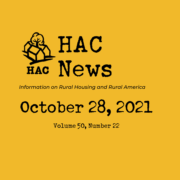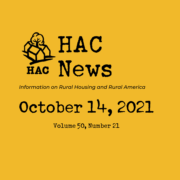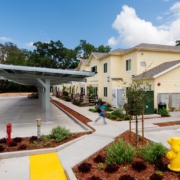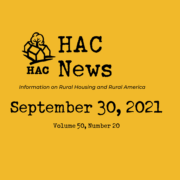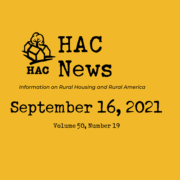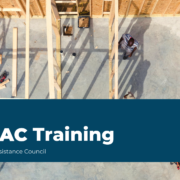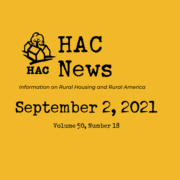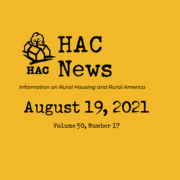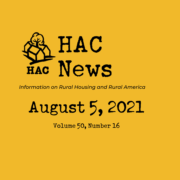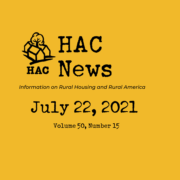HAC News: October 28, 2021
Vol. 50, No. 22
TOP STORIES
President proposes budget reconciliation bill compromise.
On October 28, as Congress and the administration continue to negotiate on social services spending, President Biden released a new Build Back Better framework that would total $1.75 trillion rather than the $3.5 trillion originally proposed. The framework would include $150 billion to “enable the construction, rehabilitation, and improvement of more than 1 million affordable homes, boosting housing supply and reducing price pressures for renters and homeowners,” though information is not yet available on how the funding would be allocated among programs. It would also establish a new Rural Partnership Program. HAC’s statement on the framework notes that these investments would bring our country much, much closer to achieving the vision of safe, decent, and affordable homes for all.
Senate committee proposes FY22 HUD funding levels.
The Senate Appropriations Committee recently released nine proposed appropriations bills, including the Transportation-HUD bill, for the fiscal year that began on October 1. The committee would increase many HUD programs above their FY21 funding levels, though generally it would not raise them to the figures proposed in the House bill. HAC’s site has details on FY22 appropriations for HUD and for USDA’s rural housing programs. The continuing resolution that currently funds the federal government will expire on December 3.
Emergency Rental Assistance spending rose in September.
State and local governments distributed nearly $2.8 billion from the Emergency Rental Assistance program to more than 510,000 households in September, up from 459,000 in August, according to newly released figures from the Treasury Department. Treasury will use this data, along with other information, to determine what funds may be reallocated to other jurisdictions.
Register now for 2021 Virtual HAC National Rural Housing Conference!
HAC invites you to join us virtually on November 30-December 3! This year’s conference features more than 30 workshops, where participants will interact and engage around best practices for rural housing and community development, organizational management, and resource development. The conference also includes a pre-conference day with gatherings for coalitions, associations, and working groups. For more information, contact HAC staff, 404-892-4824.
November is Native American Heritage Month.
RuralSTAT
In 2020, of the estimated 37,252 homeless veterans nationwide, 6,407 (17.2%) were in largely rural Continuums of Care. Source: HAC analysis of Point-in-Time data collected for HUD.
OPPORTUNITIES
Planning assistance offered for rural recreation economies.
Communities anywhere in the U.S., including territories, can apply by November 22 for Recreation Economy for Rural Communities planning assistance sponsored by the Environmental Protection Agency, the Forest Service, and the Northern Border Regional Commission. The program does not offer funding, but provides help from a planning team to identify strategies to grow a community’s local outdoor recreation economy, strengthen their downtown, and conserve and sustainably use forests and other natural assets. For more information, contact RERC staff.
Nomination deadline extended for USDA Equity Commission.
USDA will accept nominations through November 20 for membership on its new Equity Commission and Subcommittee on Agriculture. For more information, contact Dewayne L. Goldmon, USDA, 202-997-2100.
USDA to offer broadband funds.
Nonprofits, for-profits, limited liability entities, coops, tribes, states or local governments, and U.S. territories are eligible for loans, grants, and loan/grant combinations through USDA’s Rural eConnectivity (ReConnect) Program to construct, improve, or acquire facilities and equipment to facilitate broadband deployment in rural areas. USDA will accept FY22 applications from November 24, 2021, through February 22, 2022. For more information, contact Laurel Leverrier, USDA, 202-720-9554.
HAC seeks Housing Specialist and Community Facilities Housing Specialist.
- The Housing Specialist is primarily based in either the Southwest or Western states (within two hours of a major airport) and works with local partner organizations to identify financial resources and funding opportunities to support the preservation and development of affordable housing and community and economic development strategies specifically throughout expanses of Southwest and/or Western rural America. This position is remote location eligible.
- The Community Facilities Housing Specialist identifies and engages community stakeholders and provides direct technical assistance to rural organizations that are developing facilities such as parks, community centers, public libraries and childcare centers. This is a two-year position and is eligible for telecommuting.
REGULATIONS AND FEDERAL AGENCIES
Input requested on protecting workers against heat.
As the first step towards protecting indoor and outdoor workers from hazardous heat, the Occupational Safety and Health Administration seeks information about hazardous heat in the workplace, interventions and controls that can be used, and what OSHA should consider in developing standards. Comments are due December 27. For more information, contact Andrew Levinson, OSHA, 202-693-1950.
Fair lending enforcement initiative launched.
On October 22 the Justice Department announced a new Combatting Redlining Initiative to step up its enforcement of fair lending laws. The department says it will take into account local expertise on housing markets and the credit needs of local communities of color, expand its consideration of potential redlining by non-depository lenders (which are not traditional banks, but which now issue the majority of mortgages in the U.S.), and strengthen its partnership with financial regulatory agencies.
HAC recommends focus on racial and geographic equity in Fannie Mae and Freddie Mac plans.
HAC’s response to a Federal Housing Finance Administration request for comments supports a requirement for Fannie Mae and Freddie Mac to develop plans for advancing equity in housing finance over the next three years. HAC encourages the Equitable Housing Finance Plans to consider the unique needs of rural communities of color.
Coalition asks for Duty to Serve improvements.
A new Underserved Mortgage Markets Coalition of 20 organizations including HAC wrote to Federal Housing Finance Administration acting director Sandra Thompson requesting improvements in the regulations governing Fannie Mae and Freddie Mac’s Duty to Serve obligations and in their 2022-24 Duty to Serve plans. The group also supported FHFA’s new requirement for Equitable Housing Finance plans.
HAC urges Census Bureau to expand data offerings.
In comments on the new 2020 Census Data Product Planning Crosswalk, HAC encourages the Census Bureau to provide sub-county geographies in all elements of the new crosswalk and in all of its public-use data products. County-level data may dilute or mask rural populations, HAC noted, particularly in the Western U.S. where counties cover large geographic areas.
PUBLICATIONS AND MEDIA
Affordability restrictions expire for over 700,000 federally assisted homes in the next 10 years.
Nearly 5 million rental homes were supported by federal project-based assistance in 2020, representing 10% of the U.S. rental housing stock, according to the 2021 Picture of Preservation by the Public and Affordable Housing and Research Corporation and the National Low Income Housing Coalition. Nationwide, the Low Income Housing Tax Credit supports half of the federally assisted housing stock, followed by project-based Section 8 (28%), public housing (18%), and USDA Section 515 (8%). The report summarizes current challenges to preserving the affordability of these rentals and recommends improvements.
Water scarcity impacts affordable housing development in California.
Water Shortage Intensifies Valley’s Rural Housing Crisis, an article published by GV Wire, reports that water scarcity and lack of infrastructure prevent building more affordable housing in the San Joaquin Valley in California. Cities can usually afford to build sewer infrastructure or dig wells, but in rural areas the burden falls on developers.
Connections between mental health, health equity, and housing explored.
Anti-Racism Sparks Movement for Trauma-Informed Design, an essay in Build Healthy Places Network’s Crosswalk Magazine, describes how affordable housing can help address trauma and uplift residents’ voices to foster collective healing.
Temporary “shack” demonstrates rural housing quality problems.
Woman Lives in a Shack to Fundraise for Rural Housing Repairs describes the efforts of Lisa Pierce to draw attention to rural housing needs. The article in U.S. News & World Report explains that Rev. Pierce, of Alabama Rural Ministry, stays in the shack in downtown Auburn for about a week each year as part of a fundraiser called “No More Shacks.” The nonprofit uses the proceeds to repair substandard homes in rural Alabama.
Supplemental nutrition program benefits rural economy.
A recent study by USDA’s Economic Research Service, Impact of USDA’s Supplemental Nutrition Assistance Program (SNAP) on Rural and Urban Economies in the Aftermath of the Great Recession, compared the effects of SNAP benefits on rural and urban economies in 2009-2014. The study found that SNAP benefit outlays generated larger impacts in the rural economy when measured as shares of output and employment.
Need capital for your affordable housing project?
HAC’s loan fund provides low interest rate loans to support single- and multifamily affordable housing projects for low-income rural residents throughout the U.S. and territories. Capital is available for all types of affordable and mixed-income housing projects, including preservation, new development, farmworker, senior and veteran housing. HAC loan funds can be used for pre-development, site acquisition, site development, construction/rehabilitation and permanent financing. Contact HAC’s loan fund staff at hacloanfund@ruralhome.org, 202-842-8600.
Please note: HAC is not able to offer loans to individuals or families. Borrowers must be nonprofit or for-profit organizations or government entities (including tribes).

